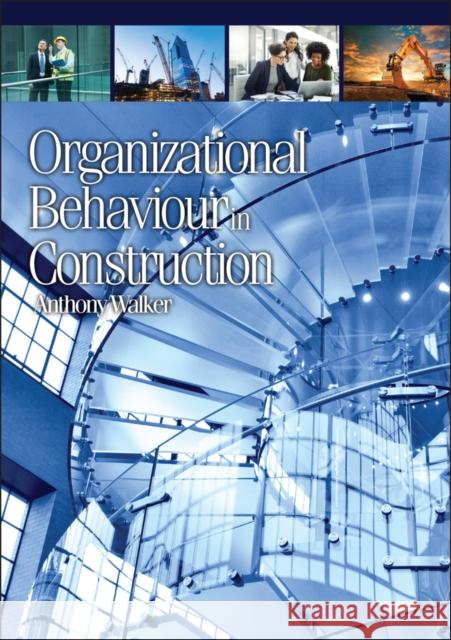Organizational Behaviour in Construction » książka



Organizational Behaviour in Construction
ISBN-13: 9781405189576 / Angielski / Miękka / 2011 / 336 str.
Organizational Behaviour in Construction
ISBN-13: 9781405189576 / Angielski / Miękka / 2011 / 336 str.
(netto: 209,17 VAT: 5%)
Najniższa cena z 30 dni: 218,27
ok. 30 dni roboczych
Dostawa w 2026 r.
Darmowa dostawa!
This book addresses the behavior of individuals and groups within the different organizations that come together on construction projects and within the organizations created to manage projects. It describes how their behavior impacts on the performance of construction organizations and their contribution to the project as a whole.
Wydanie ilustrowane
"The book would be appropriate for undergraduate and postgraduate students in construction as well as middle and senior management. While the author employs mainstream literature on organizational behavior, he effectively makes it relevant specifically to the construction industry." (Book News, 1 October 2011)
Preface.
1 Introduction.
1.1 What is organizational behaviour?
1.2 Critiques of organizational behaviour.
1.3 Working in construction.
1.4 An illustration.
1.5 The development of organizational behaviour.
1.6 Organizational behaviour, common sense and research.
1.7 The rationale of this book.
2 Individual Behaviour.
2.1 The constituents.
2.2 Ability.
2.3 Attitudes.
2.4 Attitude and behaviour.
2.5 Job satisfaction.
2.6 Job satisfaction and performance.
2.7 Job satisfaction and organizational citizenship behaviour.
2.8 Job satisfaction and client satisfaction.
2.9 Job satisfaction, turnover and absenteeism.
2.10 Personality.
2.11 Personality assessment.
2.12 Values.
2.13 Personality, values and the construction professions.
2.14 Perception.
2.15 Creativity.
2.16 The significance of individual behaviour for construction.
3 Emotions, Feelings and Stress.
3.1 Rationality.
3.2 Emotions and moods.
3.3 Disguising emotions.
3.4 Emotional stereotyping and emotional cultures.
3.5 Emotional Intelligence.
3.6 Stress.
3.7 Causes of stress.
3.8 Differences in individual responses to stress.
3.9 Consequences of stress.
3.10 Managing work–related stress.
4 Morality, Ethics and Trust.
4.1 Introduction.
4.2 The nature and scope of ethical behaviour in business organizations.
4.3 Organizational pressures.
4.4 Specific issues of ethics in business.
4.5 Professional ethics in construction.
4.6 Trust.
5 Motivation.
5.1 Introduction.
5.2 Content theories of motivation.
5.3 Process theories of motivation.
5.4 Job design and job enrichment.
5.5 Empowerment.
5.6 Rewarding employees.
5.7 A critique.
6 Communications.
6.1 Introduction.
6.2 The communication process.
6.3 Communication channels.
6.4 Listening.
6.5 Questioning.
6.6 Barriers and issues.
6.7 Aspects of organizational communication.
6.8 End piece.
7 Authority, Power and Politics.
7.1 Introduction.
7.2 Authority.
7.3 Power.
7.4 Relationship between authority and power.
7.5 Sources of power.
7.6 Personality and power.
7.7 Politics in organizations.
7.8 Types of political activity.
7.9 The ethics of political behaviour.
7.10 Power and leadership.
7.11 Authority and power in the construction process.
7.12 Politics, projects and firms.
7.13 Empowerment again.
8 Culture.
8.1 Introduction.
8.2 Definitions.
8.3 Critiques of organizational culture.
8.4 Organizational climate.
8.5 Organizational culture, types and performance.
8.6 Corporate image.
8.7 Applications to construction organizations.
8.8 Observable aspects of culture.
8.9 Creating, sustaining and changing organizational culture.
8.10 Cultures, subcultures and construction.
8.11 Culture and ethics.
8.12 Industry cultures.
8.13 National cultures.
9 Groups and Teams.
9.1 Introduction.
9.2 Defining groups and teams.
9.3 Critique.
9.4 Teams in construction organizations.
9.5 Types of group and team.
9.6 Structure and roles.
9.7 Group development.
9.8 Behaviour in teams.
9.9 Teams in general vs. project teams in construction.
10 Decision–making.
10.1 Introduction.
10.2 The rational model.
10.3 The types and nature of decisions.
10.4 Behaviour in decision–making.
10.5 Group decision–making.
10.6 Group decision–making techniques.
11 Leadership, Learning and Change.
11.1 Introduction.
11.2 Traits approach.
11.3 Behavioural approach.
11.4 Democratic vs. autocratic leadership styles.
11.5 Contingency approach.
11.6 Path–goal theory.
11.7 Vroom s decision tree approach.
11.8 Adopting different leadership styles.
11.9 Leader–member exchange theory.
11.10 Inspirational approaches.
11.11 Authentic leaders.
11.12 More widely–based leadership.
11.13 Leadership in perspective.
11.14 Leaders perceptions.
11.15 Women as leaders.
11.16 Culture and leadership.
11.17 Leadership in construction.
11.18 Learning organizations and organizational change.
11.19 The learning organization.
11.20 Organizational change.
References.
Index.
Anthony Walker BBS, MSc, PhD, FRICS, holds the title of Professor Emeritus in Real Estate and Construction at the University of Hong Kong, where he has been engaged in teaching and research since 1985, prior to which he held academic appointments in the United Kingdom. He is a chartered surveyor and has worked in Britain, the Middle East and the Far East.
The core of all successful organizations is the effectiveness with which people work together. Individuals have differing characteristics and personalities, and the manner in which they interact is the key to meeting organizational objectives. This is the case for all organizations, but particularly so in construction, which is distinctly different from other industries. Construction is complex and highly differentiated, with a wide range of specialists with disparate professional skills working in a highly integrated way to deliver projects successfully. Understanding how the people involved in construction behave and work together is necessary for projects to have successful outcomes.
Organizational behaviour is an established field in mainstream management literature but general treatments cannot reflect the specific issues and idiosyncrasies of the construction industry and the people who inhabit it. Organizational Behaviour in Construction addresses the behaviour of individuals and groups within the different organizations which come together on construction projects and within the organizations created to manage projects. It describes how their behaviour impacts on the performance of construction organizations and their contribution to the project as a whole. Drawing on mainstream organizational literature but putting it into the specific context of construction, and containing many illustrations drawn from the industry, this book will be required reading for all senior undergraduate and postgraduate students of construction, as well as middle and senior management in the industry.
1997-2025 DolnySlask.com Agencja Internetowa
KrainaKsiazek.PL - Księgarnia Internetowa









